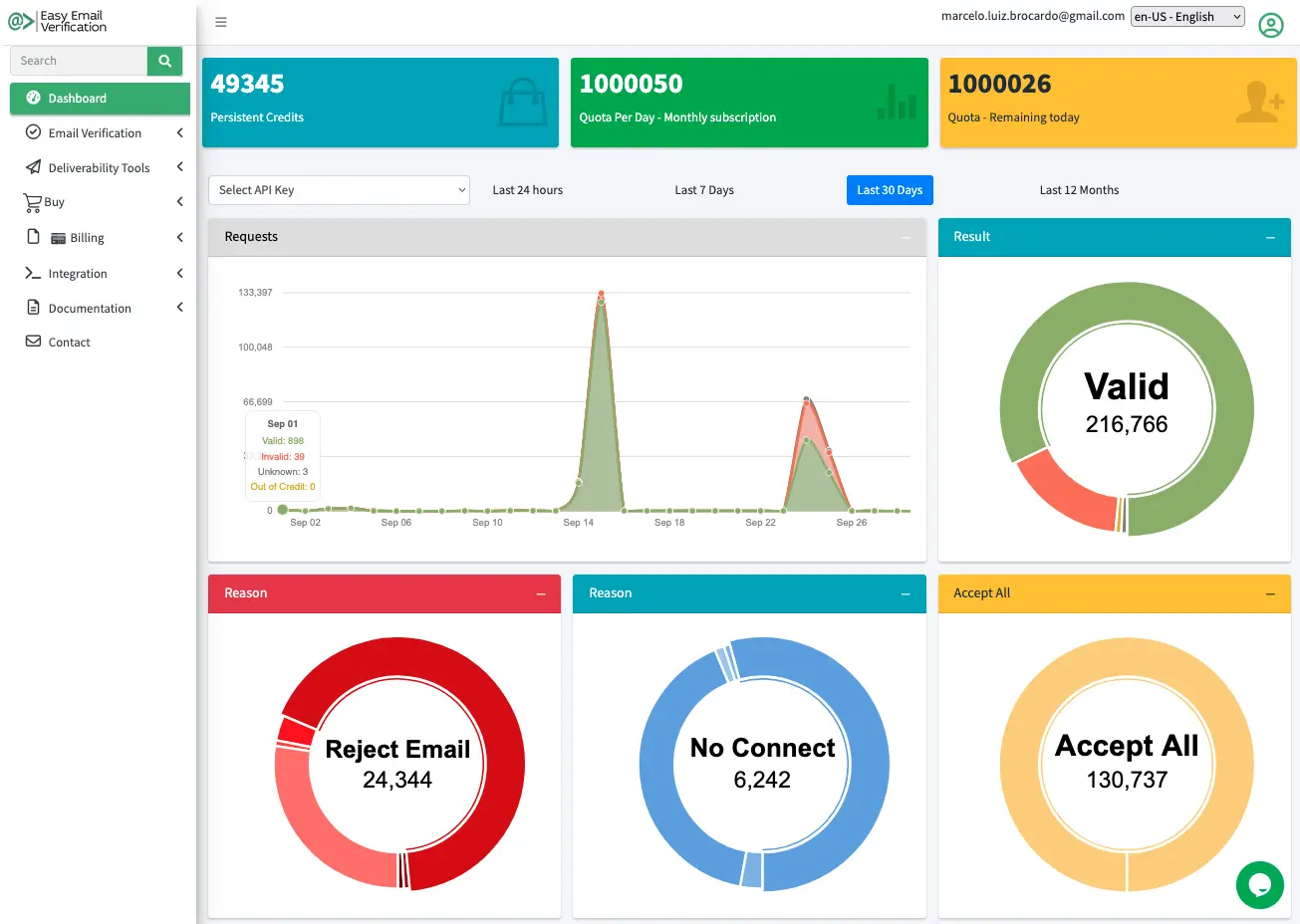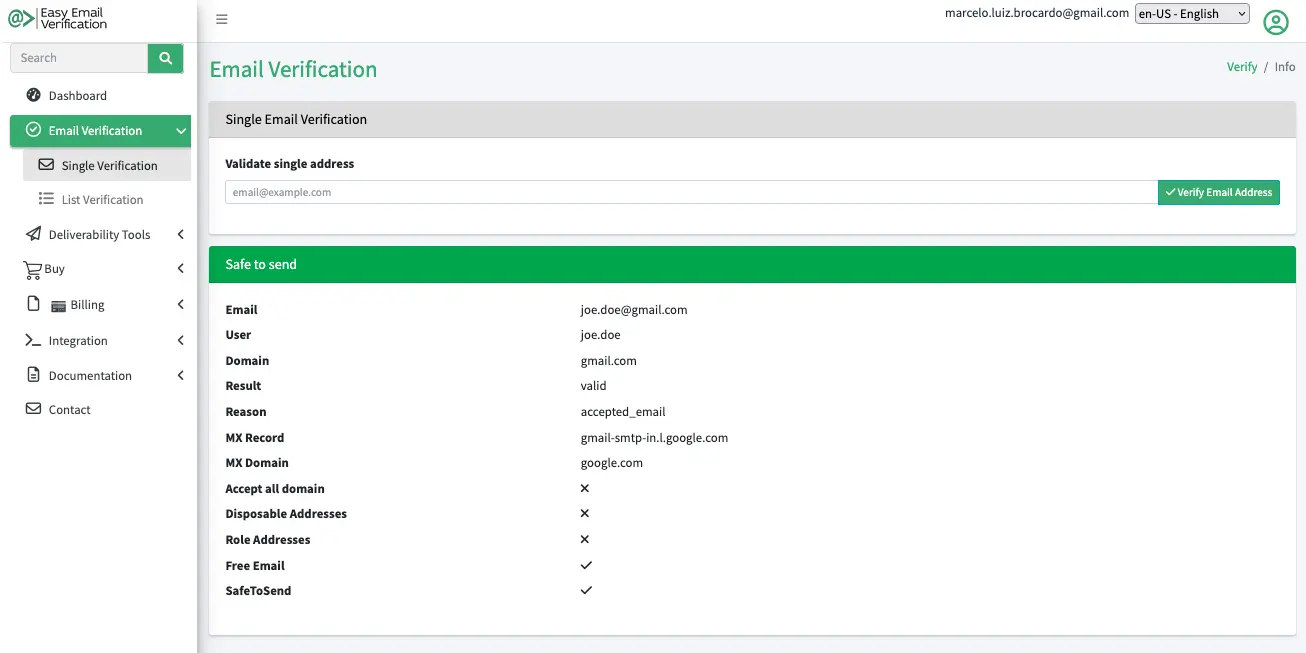Email Checker – Verify & Clean Email Addresses Instantly
Avoid bounces, improve your reputation, and ensure your emails reach the right inbox.
Avoid bounces, improve your reputation, and ensure your emails reach the right inbox.
Learn how to use our Email Checker to verify emails, improve deliverability, and ensure your messages reach the inbox, not spam.



Our email verification process is quick, reliable, and ensures high accuracy in validating email addresses
Ensures the email address follows the proper structure. An address is divided into two parts separated by @: the local part and the domain
The Email Verification Service checks MX records to identify which servers accept incoming emails for a domain and how messages should be routed.
This Email Validation Tool performs a real-time network test to confirm whether the mail server is active and accessible.
Detects if an address is registered with free providers such as Gmail, Yahoo, Outlook, or AOL.
The Email Verifier identifies domains configured as “catch-all,” meaning they accept all emails regardless of the local part.
The Email Validator flags temporary or disposable email services frequently used for one-time registrations.
Identifies whether an address is tied to a shared role (e.g., admin, support, sales) rather than a specific individual.
Performs deep SMTP-level checks to confirm whether a mailbox truly exists, without sending actual emails.
Detects common misspellings and suggests corrected versions, helping improve deliverability and reduce errors.

Bounces, spam complaints, and low open rates can all be indicative of the need to clean up your email list.
Make sure your email reaches the inbox.
If you need to verify an email address, it is quick and easy to use. Simply enter the email address you want to verify and we\'ll do the rest.
If you're using a popular email marketing tool like ActiveCampaign or ResultadosDigitais, you can automatically verify and clean your email list.
Looking to integrate email verification into your own system? Our powerful REST API makes it easy to start verifying email at scale.
Ensure accuracy and quickness when validating email addresses for your service, newsletter, trial or inquiry form.
Don't let another contact slip through the cracks because of a mistake - we can help you make sure you have the right information.
Our free-tier plan gives you a free trial of 50 email verifications per day. Try ours out without any commitment today!
We process your data online and never store your queries or keep any email data.
Plans start at $4 per month for 500 emails. Choose between pay-as-you-go or monthly subscription.
With API libraries for pretty much every programming language, EasyEmailVerification fits seamlessly into any stack.
You have a wide choice of checks depending on your needs. All cards are accepted.
Credits never expire. Purchase only the number of APIs credits you require with this package. Credits do not expire and more can be purchased as needed.
No setup fees. Each day you can use up to the maximum number of credits indicated in your plan and pay accordingly. You may switch plans at any time depending on your business needs. Unused credits do not roll over to the next period.


No Credit Card Required
Email checker is a critical part of any email marketing campaign. It helps to ensure that your emails are delivered to the correct recipients, and that your messages are not marked as spam. Email verification can also help you to avoid having your email account suspended or your IP address blacklisted. Check some common questions about email verification.
You can check if an email is valid by using an email verification tool. It tests the format, verifies MX records, and checks the server to confirm the mailbox exists without sending an actual email.
To check an email address, enter it into an online email checker. It instantly validates the syntax, domain records, and connection to ensure the address is safe to use.
You can check email either by logging into your email provider (Gmail, Outlook, Yahoo, etc.) or by using an email checker service to confirm if the address is valid and active.
An email is valid if it has a proper format ([email protected]), a real domain, and a functioning mailbox. Use an email validator to test these in real time.
To see if an email is valid, use a verification tool that performs SMTP checks and domain lookups. This ensures the email can receive messages.
Yes, many banks allow you to send a digital check through email using secure platforms. However, always use trusted services to ensure safe delivery.
To check iCloud email, log in at icloud.com with your Apple ID, or set up the account in your email client. If you want to check if an iCloud address is valid, use an email verification service.
Use an email address verifier to confirm the format, domain, and mailbox existence. This reduces bounces and improves email deliverability.
You can check your email through a webmail provider (like Gmail, Yahoo, Outlook) or a mail client (Apple Mail, Thunderbird). For validity checks, use an email verification tool.
To check archived emails, open your email provider (Gmail, Outlook, Yahoo, etc.) and look for the Archive or All Mail folder. From there, you can search and restore old messages.
Our tool validates addresses by testing syntax, domain records (MX), and server connections. It ensures your list is clean and reduces bounce rates.
No. A professional email verifier checks validity by connecting to the server via SMTP without sending an actual email, keeping the process safe.
Yes. By removing invalid, disposable, and risky addresses from your list, an email checker improves sender reputation and inbox placement.
Validation confirms the format is correct, while verification goes further by checking domain records and mailbox existence.
Yes. Most email verification services allow bulk uploads (CSV, Excel) to check thousands of emails at once, saving time and improving campaign quality.
Absolutely. Reputable tools use secure connections, don’t send messages, and comply with privacy regulations like GDPR and LGPD.
To maximize deliverability, verify emails before each campaign, remove bounces monthly, and monitor your sender reputation. Using EasyEmailVerification helps keep your list clean and ensures higher inbox placement rates.
EasyEmailVerification stands out by offering faster validation speed, higher accuracy rates, and free daily verifications. It also provides a powerful API, integration with major email platforms, and GDPR-compliant data processing.